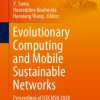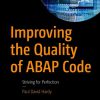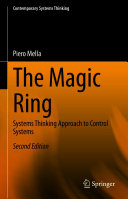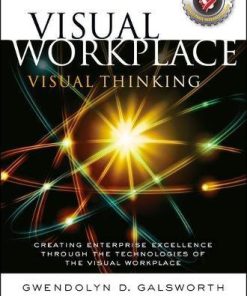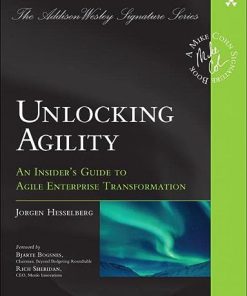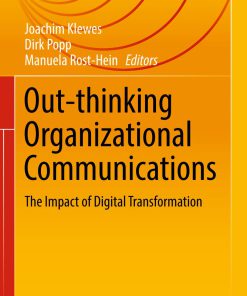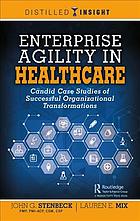The Journey to Enterprise Agility Systems Thinking and Organizational Legacy 1st Edition by Daryl Kulak, Hong Li 3319540870 9783319540870
$50.00 Original price was: $50.00.$25.00Current price is: $25.00.
The Journey to Enterprise Agility Systems Thinking and Organizational Legacy 1st Edition by Daryl Kulak, Hong Li – Ebook PDF Instant Download/DeliveryISBN: 3319540870, 9783319540870
Full download The Journey to Enterprise Agility Systems Thinking and Organizational Legacy 1st Edition after payment.
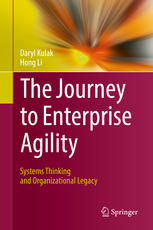
Product details:
ISBN-10 : 3319540870
ISBN-13 : 9783319540870
Author: Daryl Kulak, Hong Li
This is the first book to seriously address the disconnection between nimble Agile teams and other groups in the enterprise, including enterprise architecture, the program management office (PMO), human resources, and even business executives. When an enterprise experiments with practice improvements, software development teams often jump on board with excitement, while other groups are left to wonder how they will fit in. We address how these groups can adapt to Agile teams. More importantly, we show how many Agile teams cause their own problems, damaging scalability and sustainability, by requiring special treatment, and by failing to bridge the gaps between themselves and other groups. We call this phenomenon “Agile illth.” Adopting a set of “best practices” is not enough. All of us, Agile teams and the corporate groups, must change our intentions and worldviews to be more compatible with the success of the enterprise. Join us on the journey to enterpriseagility. It is a crooked path, fraught with danger, confusion and complexity. It is the only way to reach the pinnacles we hope to experience in the form of better business value delivered faster for less cost.
The Journey to Enterprise Agility Systems Thinking and Organizational Legacy 1st Table of contents:
1: Today´s Problems with Enterprise Business Software
Test Drive Your Knowledge
1.1 The New, New Thing
1.2 Cheap Green Shirts
1.3 Help! We´re Terrible!
1.4 Aristotle, Descartes and Disconnection to Business Value
1.5 The Mechanical Business World
1.5.1 The Question of Business Value
1.6 Scalability and Sustainability
1.6.1 The Story of Sticky LaGrange
1.7 Yes, But What About the Illth?
1.7.1 Agile Illth
1.8 Our Software Industry Problems Can Be Overcome
Test Drive Your Knowledge Again
Reference
2: The Scholars of Systems Thinking
Test Drive Your Knowledge
2.1 Hard and Soft Systems Thinking
2.1.1 Don´t Worry: This Will Not Be a Complete History of Systems Thinking
2.2 Systems Thinking Forms the Basis
Test Drive Your Knowledge Again
3: Worldview and Intentions
Test Drive Your Knowledge
3.1 Borrowing from the Buddha
3.1.1 Right View
The Agile Manifesto
3.1.2 Right Intention
3.1.3 Right Speech
3.1.4 Right Action
3.2 Right View + Right Intention + Right Speech + Right Action
3.2.1 A Worldview That Is Compatible with Success
Test Drive Your Knowledge Again
Reference
4: Seven Principles of Systems Thinking for Software Development
Test Drive Your Knowledge
4.1 So Many Principles!
4.1.1 Systems Thinking Principle 1: Trust=Speed
4.1.2 Systems Thinking Principle 2: Avoid Best Practices
4.1.3 Systems Thinking Principle 3: Beware the Immense Power of Analogies
4.1.4 Systems Thinking Principle 4: Blame the System, Not the Person
4.1.5 Systems Thinking Principle 5: Treat People Like People, Not Like Machines
4.1.6 Systems Thinking Principle 6: Acknowledge Your Boundaries
4.1.7 Systems Thinking Principle 7: Relation-ness Matters More Than Thing-ness
4.2 Principles for Your Worldview
Test Drive Your Knowledge Again
References
5: Redefining Professionalism
Test Drive Your Knowledge
5.1 Understanding What It Means to Be a Professional
5.1.1 What Defined the Professionalism of the Past?
5.1.2 Mechanical Professionalism
5.2 The New Professionalism
5.3 The Principles of the New Professionalism
5.3.1 New Professionalism Principle 1: Speak Up!
5.3.1.1 The Stanford Prison Experiment
5.3.1.2 Just “Go Along´´
5.3.1.3 You Know What? I´ll Just Become a Monk!
5.3.1.4 Building Trust
5.3.2 New Professionalism Principle 2: Solving Communication Problems with Via Negativa
5.3.2.1 Via Negativa!
5.3.2.2 A Different Way to Solve Communication Problems
5.3.2.3 Addition Often Has More Bad Side-Effects
5.3.2.4 Via Negativa for Retrospective Follow-Up Items
5.3.3 New Professionalism Principle 3: Be an Advocate for Weak or Absent Voices
5.3.3.1 General Motors Calculates Loss of Their Customers´ Lives
5.3.3.2 Sony Builds a Back Door for Itselfand Hackers
5.3.3.3 Sorry, But Here´s One More Story About Weak Voices
5.3.3.4 Weak and Powerful Stakeholders
5.3.3.5 Well I, For One, Would Never Do That!
5.3.3.6 The New Professional as Advocate
5.3.3.7 Representing Those Without a Voice
5.3.4 New Professionalism Principle 4: Proudly Display Your Dirty Laundry
5.3.5 New Professionalism Principle 5: Connect People to One Another
5.3.6 New Professionalism Principle 6: Challenge Your Own Assumptions as Much as You Challenge Other
5.3.7 New Professionalism Principle 7: Be Accountable to Change
5.3.8 New Professionalism Principle 8: Manage Uncertainties Through Adaptive Practices and Stop Faki
5.3.8.1 Mediocristan and Extremistan
Software Development: Which `stan Do We Live In?
A Casino Misses Its Losses
5.3.8.2 Risk Management for Software Development
5.3.8.3 Managing Uncertainties with Adaptive Practices
5.3.9 The Worldview of the New Professional
Test Drive Your Knowledge Again
Try This Next
References
6: Scaling and Sustaining: Avoiding Mechanical Behavior
Test Drive Your Knowledge
6.1 The Burning Question on Robert Rosen´s Mind
6.2 Allow Me to Work Somewhere Fit for Humans
6.3 Are Humans Similar to Software?
6.4 But Agile Ain´t Mechanical, Is It?
6.5 Conversations with a Terrible Coach
6.6 Why? What´s the Purpose?
6.6.1 Thin Knowledge Versus Thick Knowledge
6.6.2 Why? Tell Me Your Thought Process
6.7 What Type of Organization Do You Work In?
6.8 Agile Practices and the “Why´´ Behind Them
6.8.1 Be a Skeptical Empiricist
6.8.2 Run a Process Experimentation Lab in Every Team Space
Test Drive Your Knowledge Again
Try This Next
References
7: Business Value, Estimation and Metrics
Test Drive Your Knowledge
7.1 Do We Really, Honestly Need a PMO?
7.2 How an Idea Becomes a Project
7.3 The Problems with Today´s Portfolio Management Processes Are
7.3.1 The Annual Portfolio Management Cycle
7.3.2 Projects Incur Unnecessary Costs and Risks
7.3.3 Early Estimates Are Inaccurate
7.4 Ideas for Portfolio Management
7.4.1 The Fleeting Concept of Value
7.4.2 Value Stories
7.4.3 The Cisco Rule
7.4.4 Prioritizing Value Stories
7.4.5 Slicing Value Stories
7.4.6 The Real Day-to-Day Magic of Value Stories
7.4.7 “Get Me a Black Truck!´´
7.4.8 Three Levels of ROI: Thin, Thick and “Thurmanator´´
7.4.8.1 Thin ROI
7.4.8.2 Thick ROI
7.4.8.3 Thurmanator ROI
7.4.9 Metrics
7.4.9.1 Metrics About Progress
Burndown Charts
Velocity Charts
Code Coverage Charts
Other Types of Progress Charts
7.4.9.2 Metrics About Problems
How Symbol Technologies Innovated Past Their Keyboard Problems
7.4.10 Estimation
7.4.10.1 Estimating Versus Sizing
7.4.10.2 And Now, Here Are Storypoints, the Abstracted Buckets You´ve Been Waiting For
Mohs Scale of Mineral Hardness
Storypoints and Executives Do Not Mix
The Relationship Between Storypoints and Hours
7.4.10.3 Sprint Commitments
7.5 MeanwhileBack in the Team Space
7.6 Portfolio Management Does Not Have to Be a Dinosaur
Test Drive Your Knowledge Again
Try This Next
References
8: Missing Deadlines Means Missing Market Opportunities
Test Drive Your Knowledge
8.1 How to Miss a Deadline
8.2 Why Requirements Is a Bad Word
8.2.1 Shotgun or Rifle Approach?
8.2.2 Adding a Sponge to the Iron Triangle
8.2.3 Acceptable and Unacceptable Responses to the Business
8.2.4 The Steel Query Application
8.3 “How Much Will It Cost?´´ Is the Wrong Question
8.3.1 Thinking in Buckets
8.3.2 Short Sprints Really Help
8.4 Stop Thinking Like an IT Person: Think Like a Businessperson
8.5 Things Move So Dang Fast
Test Drive Your Knowledge Again
Try This Next
Reference
9: Flipping the Run/Build Ratio: The Business Case for Software Craftsmanship
Test Drive Your Knowledge
9.1 Just Keeping the Lights On
9.2 Software Craftsmanship: How a Movement Among Developers Is Good for Business
9.2.1 Software Craftsmanship Practices
9.2.1.1 Clean Code
9.2.1.2 Pair Programming
9.2.1.3 Test-Driven Development (TDD)
9.2.1.4 Continuous Integration
9.2.1.5 Behavior-Driven Development (BDD)
9.2.1.6 Legacy Rescue
9.2.1.7 Screaming Architecture
9.2.2 Software Craftsmanship with Commercial Packaged Software
9.3 DevOps
9.4 The Intention of Software Craftsmanship
Test Drive Your Knowledge Again
Try This Next
References
10: Better Vendor RFPs and Contracts
Test Drive Your Knowledge
10.1 Let´s Put It Out to Bid!
10.2 The Alan Shepard Principle
10.3 A Better Way to Write RFPs
10.3.1 RFPs with Value Stories
10.3.2 Sprint Zero Contract with Follow-On
10.3.3 Connecting Non-Agile Vendors to Your Agile Process
10.4 Working with Vendors Is Not Always Easy
Test Drive Your Knowledge Again
Try This Next
11: Servant Leadership
Test Drive Your Knowledge
11.1 The Basis of Servant Leadership
11.1.1 Needs Not Wants
11.1.2 Management and Leadership
11.1.2.1 Management and Leadership at the Movies
11.1.2.2 Battling Hunger in Sub-Saharan Africa
11.2 A Leadership Culture
11.3 The Nine Leadership Principles
11.3.1 Leadership Principle 1: Bring Decision-Making as Close to the Work as Possible
11.3.2 Leadership Principle 2: A Leader Is Anxious When the Team Is Calm and Calm When the Team Is A
11.3.3 Leadership Principle 3: A Leader Is a Systems Scientist
11.3.4 Leadership Principle 4: A Leader Understands the Benefits and Dangers of Measurement
11.3.5 Leadership Principle 5: A Leader Negotiates
11.3.6 Leadership Principle 6: A Leader Leads Across Team Boundaries Using Scouts and Ambassadors
11.3.7 Leadership Principle 7: A Leader Organizes Field Trips
11.3.8 Leadership Principle 8: A Leader Is a Student of Corporate Culture
11.3.9 Leadership Principle 9: A Leader Respects the Psychological Contract
11.4 The Desolate Wasteland of Management Training
11.5 Getting Started with Servant Leadership
Test Drive Your Knowledge Again
Try This Next
References
12: How Teams Keep Learning and Improving
Test Drive Your Learning
12.1 Continuous Improvement with W. Edwards Deming
12.1.1 The Shewhart Cycle
12.1.1.1 Plan
12.1.1.2 Do
12.1.1.3 Study
12.1.1.4 Action
12.1.2 The Trouble with Self-Reinforcing Feedback
12.2 Where´s the System?
12.3 How Long Is a Sprint?
12.4 Lightning Talks
12.5 Learning, Improving
Test Drive Your Knowledge Again
Try This Next
References
13: Getting Coaching That Really Helps
Test Drive Your Knowledge
13.1 Fighting Poverty in Rural China
13.2 How to Transform an Organization?
13.2.1 Shu-ha-ri
13.2.2 The Alternative to Shu-ha-ri
13.2.3 Scrum and Done!
13.2.4 Aspects of a Transformation
13.3 Coaches Who Just Coach: NO; Extensive Training Sessions: NO; Certification: HELL NO
13.4 Talker+Doer
13.5 Six Questions to Ask Your Agile Coach or Consultant
13.6 People Don´t Resist Change
Test Drive Your Knowledge Again
Try This Next
Reference
14: Capitalizing Software Investments
Test Drive Your Knowledge
14.1 Will That Be CAPEX or OPEX?
14.1.1 CAPEX and OPEX Activities in Software Development
14.2 Why Capitalize?
14.2.1 Income Smoothing
14.2.2 Ratio Analysis
14.2.3 Reduced OPEX
14.3 Creating Financial Projections with More Confidence
Test Drive Your Knowledge Again
Try This Next
15: Integrating Enterprise Methodology and Architecture with Fast-Moving Development Teams
Test Drive Your Knowledge
15.1 The Organizational Legacy
15.1.1 Playing Nice: Avoiding Process Illth
15.2 How Development Teams Can Play Nice with Corporate Methodology Groups
15.2.1 Stage Gates
15.2.2 Project Plans
15.2.2.1 Defined Minimum or Maximum Hours Per Task
15.2.2.2 Certain Deliverables Recommended on All Projects, Agile or Not
15.2.2.3 The “Triple Constraints´´ or “Iron Triangle´´
15.2.2.4 Baselines
15.2.2.5 Estimates-to-Complete (ETCs)
15.2.2.6 Overlapping Sprints
15.2.3 Corporate Methodology Is Not the Enemy
15.3 How the Corporate Methodology Group Can Transform Its Worldview
15.4 How Development Teams Can Play Nice with Enterprise Architecture
15.4.1 Architects: Come to Our Demos!
15.4.2 Volunteer to Be an Early Adopter for New Architectural Capabilities
15.5 How the Enterprise Architecture Group Can Transform Its Worldview
15.5.1 Architects Who Write Code
15.5.2 Setting Standards
15.5.2.1 Electric Cars Need a Standardized Battery, Right? or No?
15.5.3 Emergent Architecture
15.5.4 What´s That Sound? Is Your Architecture Screaming?
15.5.5 Test-Driven Architecture
15.5.6 Being an Architect Is Not the Desired Career Path for Every Developer
15.6 A Word About Bimodal IT
15.7 The Corporate Immune System
Test Drive Your Knowledge Again
Try This Next
Reference
16: HR Agility
Test Drive Your Knowledge
16.1 Why Did Churchman Quit the Field He Pioneered?
16.2 Changing Your HR Worldview: People Aren´t Your Resources
16.2.1 The Neighborhood Nurses
16.3 Evaluating People
16.3.1 Reduce the Document Focus
16.3.2 Performance Appraisals
16.4 Rewarding People
16.4.1 Goal-Setting and Specific Targets
16.4.2 Tangible Rewards
16.4.3 Work That Is Challenging, but Not Overwhelming
16.4.4 The Fun Committee
16.5 Teams Competing Against One Another
16.6 Promotion Paths
16.6.1 Leadership Promotion Paths
16.7 There Is Only One Motivator
16.8 Recruiting, Interviewing and Contracting
16.8.1 Diversity and Inclusion
16.8.2 Don´t Fetishize Technical Skills in Interviews
16.8.3 The Use of Contractors and Contracted Services
16.9 Changing the Culture
16.9.1 Look! I´ll Change the Culture by Replacing the People!
16.9.2 Being a Student of Corporate Culture
16.10 How Team Roles Change
16.10.1 Thinner Management Layers
16.10.2 User Interface Designers
16.10.3 Generalizing Specialists
16.11 Allocating People´s Time
16.11.1 Competency Centers
16.11.2 Time-Slicing People Is the Biggest Productivity Killer in the Known World
16.12 HR Is a Big Part of an Agile Transformation
Test Drive Your Knowledge Again
Try This Next
References
17: Buy Versus Build
Test Drive Your Knowledge
17.1 The Character of Your IT Shop
17.2 To Buy or to Build?
17.2.1 What Business Are You In?
17.2.1.1 But We´re a Bookstore!
17.2.1.2 Products “Wrapped in Information´´
17.2.1.3 Software as a Competitive Advantage
17.3 It Might Not Be Buy Versus Build: It Could Be Buy and Build
17.4 Where Are You on the Emotional Spectrum of Packaged Software?
Test Drive Your Knowledge
Try This Next
Reference
18: A Brief Note About Using Offshore Teams
Test Drive Your Knowledge
18.1 Mind-Body Separation
18.1.1 Slice at the Thinnest Part
18.2 High and Low Bandwidth Communication
18.2.1 Those Tricky Metaphors
18.3 Large Distributed Teams Can Work
Test Drive Your Knowledge
Try This Next
19: Highlighting the Differences Between Software Product Companies and Internal IT
Test Drive Your Knowledge
19.1 The Role of Software in Your Organization
19.1.1 Making Money by Selling Software Versus a Software Cost Center
19.1.1.1 Revenue Value Stories
19.1.1.2 Expense Value Stories
19.1.2 A Software Subsidiary
19.2 Product Managers and Product Owners
19.3 Selling Software or Just Using It
Test Drive Your Knowledge Again
Try This Next
20: Conclusion
People also search for The Journey to Enterprise Agility Systems Thinking and Organizational Legacy 1st:
what is enterprise agility
the journey to enterprise agility
the journey to an agile organization
enterprise agility vs business agility
the journey to an agile organization. mckinsey & company
Tags: The Journey, Enterprise Agility, Thinking, Organizational Legacy, Daryl Kulak, Hong Li
You may also like…
Business & Economics - Management & Leadership
Computers - Hardware
The Magic Ring Systems Thinking Approach to Control Systems 2nd Edition Piero Mella
Business & Economics - Management & Leadership
Business & Economics
Relationships & Lifestyle - Diet & Nutrition
Get Off Your Sugar 1st Edition by Dr Daryl Gioffre ISBN 0738286222 978-0738286228
Business & Economics - Management & Leadership


